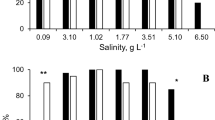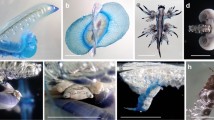Abstract
Abundance and reproductive biology (gonad maturation and egg production) of the Arctic copepod Calanus glacialis were studied in the Laptev Sea and adjacent Arctic Ocean in September 1993 and from July to September 1995. Both abundance and reproductive activity were subject to strong spatial and seasonal variability, which was related to the ice cover, feeding conditions and circulation pattern. Maximum abundance of the C. glacialis population was generally confined to the outer shelf and slope with depths between 50 and 1000 m. During both cruises, highest egg production rates and largest number of young copepodite stages were observed in the eastern Laptev Sea, where the development of the C. glacialis population seems to follow the opening of the “Siberian Polynya”. In the western part, which is usually covered by pack ice, females were all immature, and no young stages were found. However, females responded quickly to a temporary opening of the ice there in 1995 and spawned. Starvation experiments showed that food-independent reproduction fuelled by internal energy resources was at least partly responsible for relatively high egg production rates at low ambient food concentrations. Egg production rates in starved females were considerably higher than those previously reported.
Similar content being viewed by others
Author information
Authors and Affiliations
Additional information
Accepted: 14 June 2000
Rights and permissions
About this article
Cite this article
Kosobokova, K., Hirche, HJ. Reproduction of Calanus glacialis in the Laptev Sea, Arctic Ocean. Polar Biol 24, 33–43 (2001). https://doi.org/10.1007/s003000000171
Issue Date:
DOI: https://doi.org/10.1007/s003000000171




